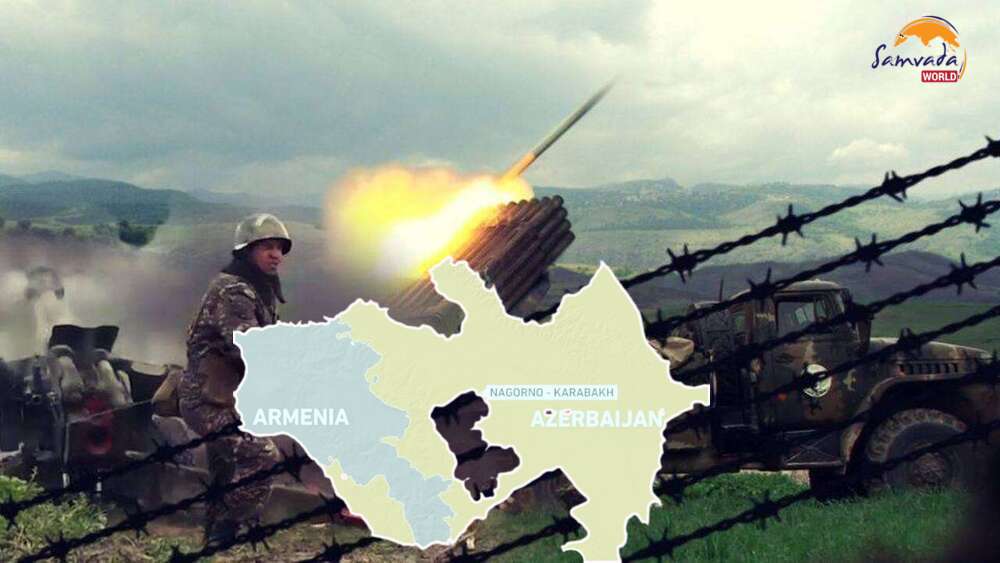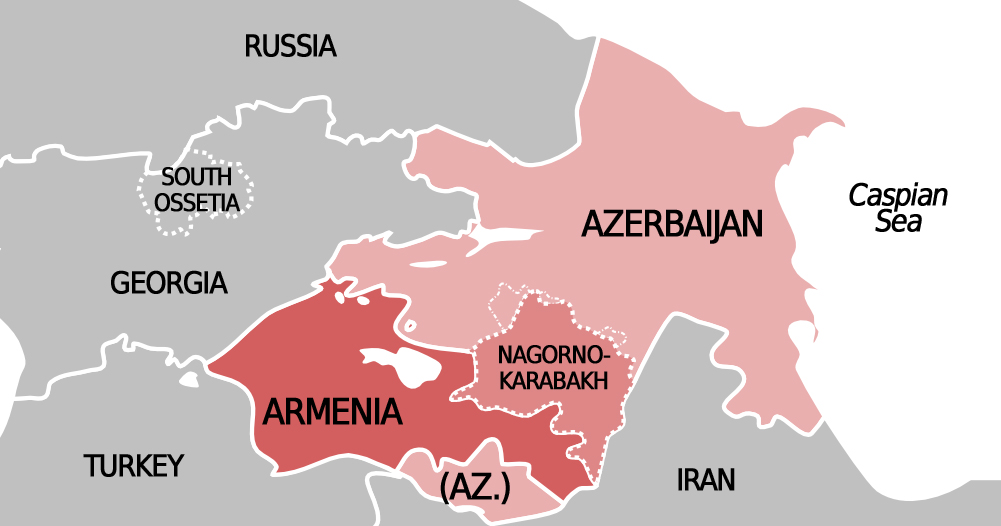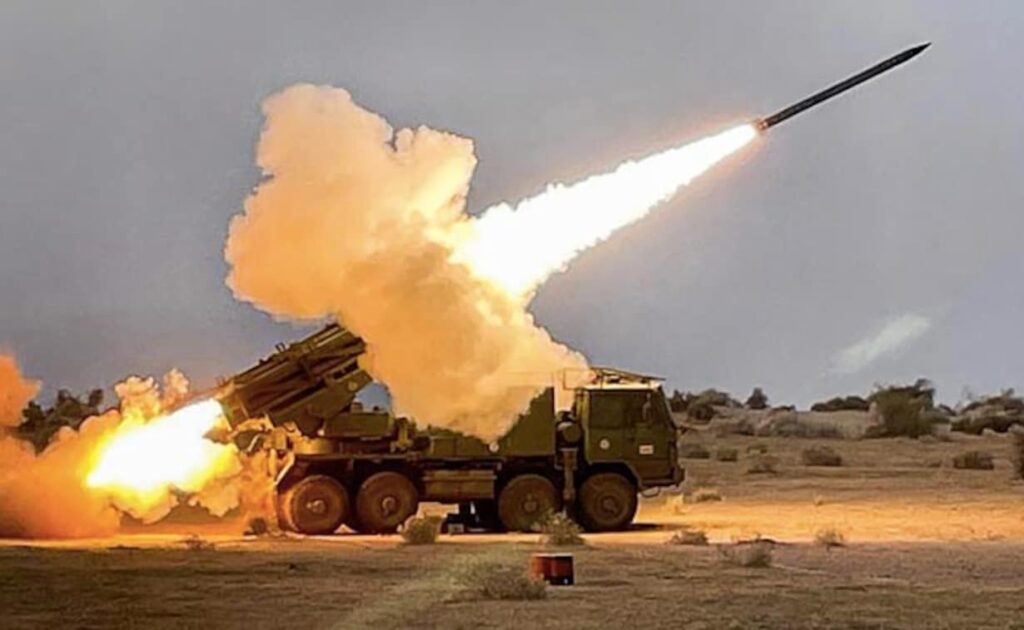
- The region has become one of the world’s third most militarized zones in the last two and a half decades.
- Over the years, many negotiations have taken place, and a few resolutions have also been put out by the UN to stop the conflict.
- The latest conflict has regional and geopolitical dimensions shaped by current events in Ukraine and Iran.
- The strategic aspect of the Pinaka agreement is that Armenia’s adversary is Azerbaijan, a member of the burgeoning trilateral cooperation with Pakistan and Türkiye.
- The Pinaka deal is crucial to square off the meddling by Türkiye and Azerbaijan in the internal affairs of India and the development of the military and political nexus between them.
The recent tensions between Armenia and Azerbaijan over Nagorno-Karabakh, a self-declared republic within Azerbaijan in the South Caucasus region, is a conflict of decades. Both sides have claimed sovereignty over the region, fought three major wars, and have been involved in multiple clashes to gain control over it. This conflict can be understood from a regional lens and the latest geopolitical and geoeconomic realities in the region. New global players are also emerging amidst the conflict. This article explores certain regional and sub-regional players’ involvement and the repercussions of the conflict.
Brief background of the Conflict
The conflict first emerged in the region after the disintegration of the USSR in the late 1980s. Armenia and Azerbaijan declared independence from the USSR in 1991, flaring the regional conflict into a full-fledged war. Both countries committed war crimes and extra-judicial killings during the war. As a result, many people were killed, and thousands became refugees.
In 1994, the Bishkek Protocol was signed between the two newly independent states of Armenia and Azerbaijan with the help of Russia. During 1994-2020 several low-intensity wars and clashes occurred. In April 2016, four days of heavy fighting at the line of separation shook the region, killing hundreds on both sides. Consequently, the region has become one of the world’s third most militarized zones in the last two and a half decades. A dam broke in September 2020, resuming war again in the region. After six weeks, the deadly armed conflict finally ended with a ceasefire brokered by Russia. Currently, Azerbaijan controls seven districts adjacent to Nagorno-Karabakh and holds a substantial part of Nagorno-Karabakh.

Geopolitical and Geoeconomic Realities
Nagorno- Karabakh, a 1700-square-mile territory is strategically essential; geopolitical stakes are high due to its proximity to critical natural resources and being located between regional powers such as Russia, Türkiye (previously known as Turkey), and Iran. Fossil fuels are abundant in the South Caucasus region. Energy pipelines snake across the region. Natural gas and oil make up 90 per cent of Azerbaijan’s exports. Azerbaijan is now the biggest supplier of natural gas to Türkiye. Any instability in the region is bad for business all around. Azerbaijan accuses the Armenians of attacking a significant oil pipeline which the former denies. The other reason Türkiye and Azerbaijan support the offensive on Nagorno-Karabakh is that they think the dispute has been allowed to fester. Furthermore, they believe it is time to resolve this decades-old conflict once and for all.
Russia is engaged in Ukraine as the West begins to supply Ukrainian soldiers with heavier weapons and ammunition. Azerbaijan entered into a natural gas contract with the EU, taking advantage of Russia’s absence in business and the EU’s desperation for natural gas. This has given Baku a “free hand” to aggressively exert pressure on Yerevan. The conflict has provided a platform for the US to return to the region and use soft power to persuade Armenia and Azerbaijan to sign a peace treaty. This move is aimed to effectively drive out Russia and contain Iran in the South Caucasus, for known reasons. The latest conflict is not a local conflict between two hostile states. It has a regional geopolitical dimension shaped by current events in Ukraine and Iran.
Azerbaijan entered into a natural gas contract with the EU, taking advantage of Russia's absence in business and the EU’s desperation for natural gas. This has given Baku a "free hand" to aggressively exert pressure on Yerevan.
Over the years, many negotiations have taken place, and a few resolutions have also been put out by the UN (UN resolutions 874, 822, 884, and 853) to stop the conflict. Furthermore, most of the big international organizations weighed in, including the Organisation for Security and Co-operations in Europe (OSCE) Minsk Group, led by Russia, France and the United States. They came close to getting the two sides to agree on a peace plan in 2007, but it fell apart. The two sides never entirely accepted the peace plan. They fell in overcoming deep mistrust injected from the long-running conflict.
India, a New Player
Armenia is purchasing weapons from India to strengthen its military forces for deterrence. According to numerous sources, the agreement has already been reached, and India will transfer the weapons over the next few months as part of this comprehensive defence agreement. New Delhi is selling the indigenous multi-barrel Pinaka Rockets to Yerevan, developed by the Defence Research and Development Organisation (DRDO) and primarily utilised by the Indian army. For mobility, the Pinaka Rockets are installed on trucks. Each system includes six launchers, twelve rockets, and one radar. The Pinaka system is computerised, and each launcher can fire in many directions. The Armenians need the Pinaka rocket system as it is affordable and the best available option. Many countries have developed multiple-launch rocket systems, but they are expensive. The Pinaka system can fire forty-four rockets in twelve minutes up to a range of Forty kilometres, which will be effective and decisive for Armenia in fighting with Azerbaijan. India is also selling anti-tank missiles and ammunition to Armenia. Armenia’s interests are understandable; historically, Armenia purchased weapons from Russia; however, with Russia at war with Ukraine, Armenians have looked to other options, notably India.
Advantages for India
The Pinaka missile system will be exported for the first time in history. This defence pact with Armenia will improve India’s defence exports. India wants to be a supplier in the global defence industry. By 2025, the Indian government aims to produce weapons valued at 1.75 lakh crore rupees, of which 35 thousand crore rupees is for export purposes. From the standpoint of the ‘Make in India’ initiative, this deal becomes critical.

The strategic aspect of the Pinaka agreement is that Armenia’s adversary is Azerbaijan, a member of the burgeoning trilateral cooperation with Pakistan and Türkiye. These three countries have strengthened ties by signing a trilateral pact on security and military assistance. They held a combined military drill in Baku last year. Türkiye sold its deadly Bayraktar drones to Azerbaijan, giving Baku a military advantage in the ongoing conflict. Political unity among these three countries is detrimental to Indian national interests. Türkiye and Pakistan support Azerbaijan’s claim to Nagorno-Karabakh. In exchange, Azerbaijan backs Pakistan in Kashmir. India is exporting its defence equipment to counter Türkiye and Azerbaijan’s instances of using Kashmir at international forums to sideline India.
India is exporting its defence equipment to counter Türkiye and Azerbaijan's instances of using Kashmir at international forums to sideline India.
The Pinaka deal is crucial to square off the meddling by Türkiye and Azerbaijan in the internal affairs of India and the development of the military and political nexus between them. India providing lethal weapons to Armenia amid the conflict is evidence of taking a side. Yet, the official policy stays intact, under which India urged the aggressor side to end hostilities immediately and backed a bilateral resolution. The Armenia-Azerbaijan conflict has no military or economic ramifications for India. People-to-people interactions and investments among India, Armenia, and Azerbaijan are limited. One might conclude that this deal is purely a strategic decision for India.
Conclusion
The US wants a diplomatic solution to the problem but does not necessarily favour Baku and Yerevan. It wants to persuade both parties to sign a peace treaty to sideline its global rivals in the region. With the assistance of Turkiye, Azerbaijan is attempting to isolate Armenia and impose a humiliating treaty by exploiting current developments in Iran and Ukraine. Armenia requires a vision to survive. It must seek military assistance to bolster its deterrent capabilities, which it is doing through a defence agreement with India. Armenia is once again at a crossroads of great power rivalry. As of now, there seems to be no solution available in the immediate future.
(Anmol Kumar is pursuing a MA in the Department of Politics and International Studies at Pondicherry University. His area of interest is West Asia)
